What You Should Know Before Accepting a Fixed Price Model
Updated 25 Mar 2023
13 Min
3526 Views
In the commercial world, there are many types of contracts that are signed in order to get your product developed by a third party. No matter which pricing model you choose, it will have a direct impact on the process of implementation. Opting for a fixed price app development service you wash hands of the affair and wait for the developers to get the job done as soon as possible.
At Cleveroad, we make heavy use of the Fixed Price model and our customers have never been disappointed after collaborating with us on this basis.
For that very reason, I would like to dwell in more detail on what is a fixed price contract, it's special aspects, and the main benefits and drawbacks which you are likely to encounter.
What Price Model Can Bring More Revenue?
How the Fixed Price model works
First of all, let's identify the main players in the process. There are three of them:
- The client who needs their idea to be implemented in a ready product;
- The team which achieves client's dream;
- The outsource company that coordinates the effective collaboration and guarantees a top result.
This cooperation is based on a fixed cost which is charged for the work specified in advance. A fixed price project means just that. The price the quoted based on a specified amount of work and cannot be changed once the contract is signed.
This is the perfect choice for short projects. As a rule, their duration is not more than three - five months. A mandatory condition for entering into the contract is the ability to describe the future product (e.g., mobile or web application) in vivid detail. You should be abundantly clear about the capability and performance of the final software. In turn, the development team should work on every aspect following Agile methodology and offer a fixed price project estimation.
At Cleveroad, we have adopted Scrum principles that totally meet the requirements of working in a limited time and budget environment. For that, we represent the workflow with the detailed storyboards and the client decides which ones should be prioritized.
Can't decide between time and material vs fixed price? Check out our comparative guide
If you have not decided on a full set of options or intend to add or change something during the course of development, you have definitely made the wrong contract choice. Fixed price model in IT industry does not allow making significant adjustments as the project progresses. However, if such a need arises, the Cleveroad can instigate a supplementary agreement and reestimate the final cost.
Let's now consider the procedure of establishing cooperation between the client and the team on the basis of Agile fixed price contracts.
Stages of Fixed Price contract building
Eight basic steps cover the process of cooperation:
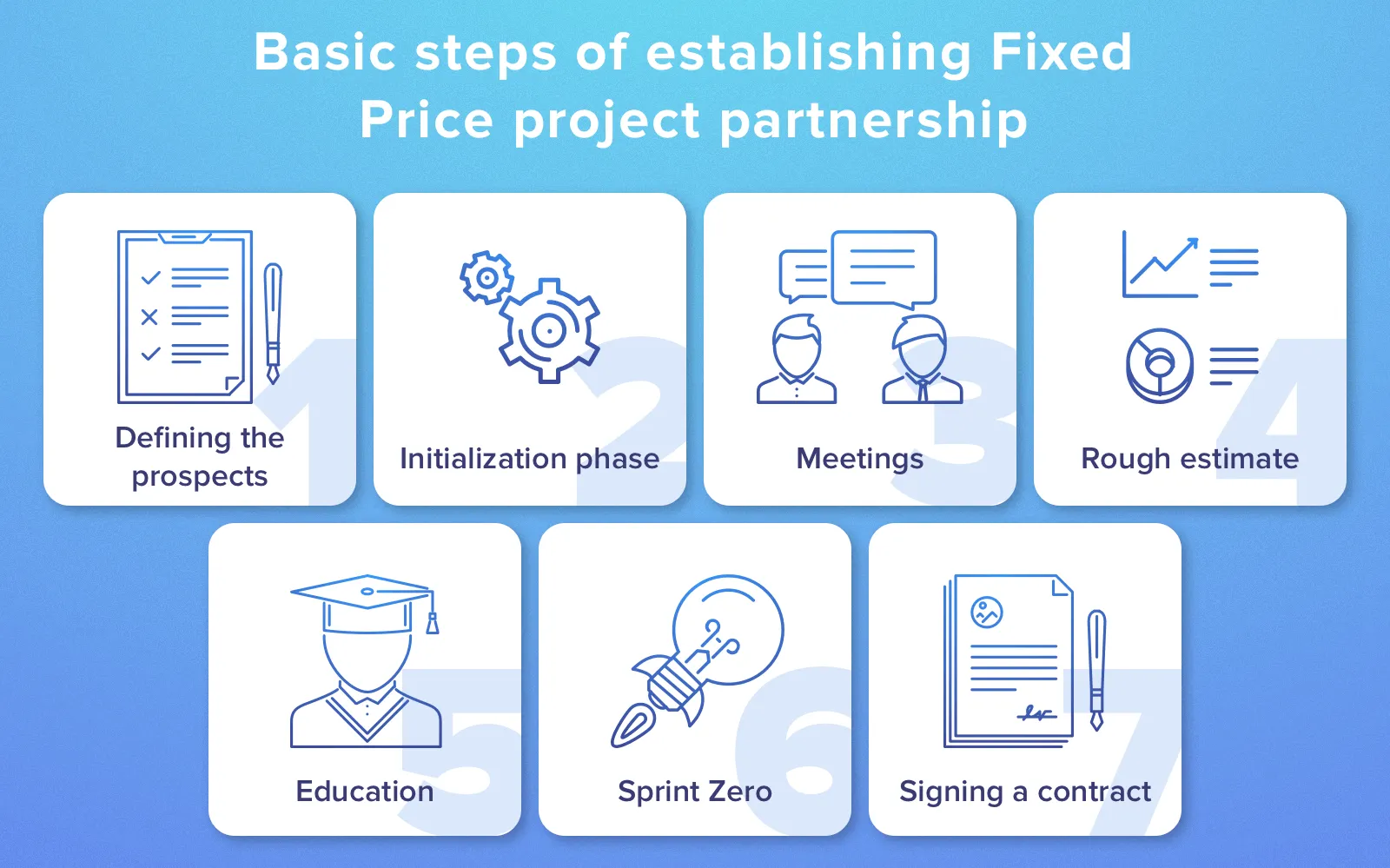
How we establish cooperation during the Fixed Price project
1. Defining the prospects
At this stage, an outsourcing company compiles a database of contacts who to may be interested in the services of the company. As a rule, the marketing department are engaged in this process. This is when the sales managers come into play and get in touch with the potential customers (prospects). It should be noted that the contact can be initiated both by the company or a client. In the first case, it is called outbound, in the second - an inbound connection.
2. Initialization phase
At this stage, the provider actually gets some idea about the future project. Before proceeding further, a project manager will prepare information about developer availability for performing the relevant tasks. Fixed price project planning will also cover an assessment of other resources (e.g., hardware, software) that will be needed.
3. Meetings
To make a rough estimate of the project, we have to collate comprehensive information about the product. This cannot be done in one conversation. During the course of negotiations, a customer may come up with additional notes you need to assume a fixed price model and the company - with counter offers and suggestions. For this reason, both parties communicate several times until all the items are agreed upon.
4. Rough estimate
At this stage, the client is given a ballpark figure - a rough idea of the project cost and duration. A draft estimate is drawn up by the representatives of the sales department. In order to provide the customer with the most extensive information, the scope of work required with a minimum and maximum price to count on. This estimate should not be taken as the final figure, as it is probably going to be significantly modified.
5. Education
Since many clients are not IT specialists, their understanding of the development process may be rudimentary or misconceived. The education phase enlightens them regarding the subtleties of fixed price contract project management. At this point, the sales managers act as consultants who shed light on the hidden pitfalls that may be encountered.
- A list of features that need to be included in an application
- The Design concept of the app
- A Project description
The last describes details concerning intellectual property rights as well as the responsibility borne by both parties in case of breach of contract.
6. Sprint Zero
This stage is also called the planning phase. It is needed to perform preparatory work before starting development. After paying a small deposit, that confirms a willingness to do business, the client receives the following list of documents:
- Requirements
- Project plan
- User Storyboards
- Wireframes
- A Test Plan
- A Detailed estimate
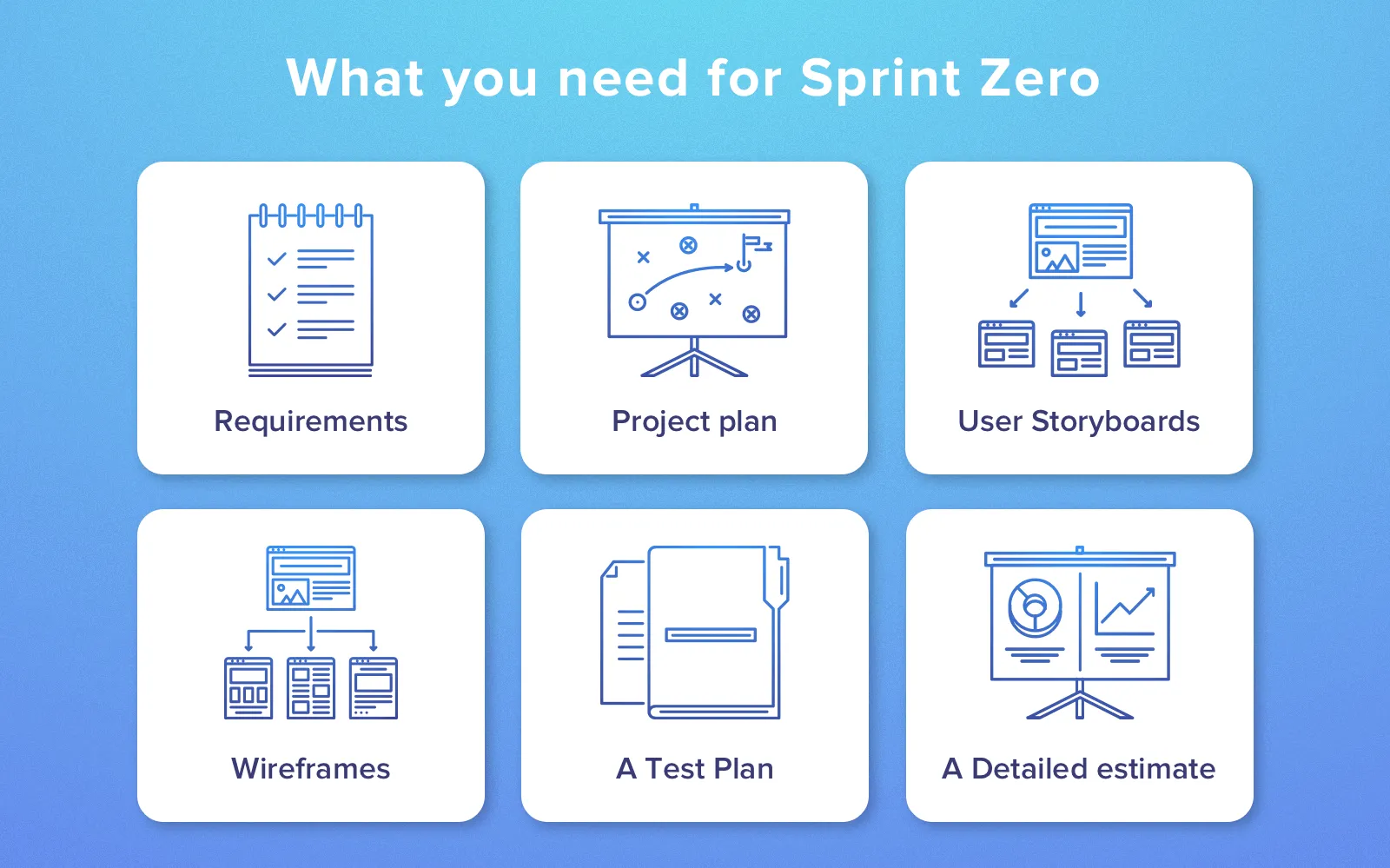
Sprint Zero during Fixed Price project management
The detailed estimate shows a precise sum that is to be paid for the project implementation. Nevertheless, it still contains both minimum and maximum columns. The first one is composed by the developers and shows a number of hours needed for coding of each option. The second one is arranged by the sales managers and shows the upper limit of the amount of time to reckon on if the necessity to do bugs fixing arises.
If for some reason the developers cannot complete the project within the defined time, the additional costs fall on the shoulders of the provider. The client does not pay in addition.
If the work is completed faster than it was planned, the client pays for the actual hours worked.
Note that the time needed for implementation of one option cannot be transferred to any other option.
7. Signing a contract
Once all the details are agreed and both the parties sign a fixed price contract, software development process begins.
Types of Fixed Price contract
It should be noted that the above scheme is usually applied in cases where the client does not have a detailed description of the project and the specification was originally drawn up by company representatives.
In this situation, it is very convenient to work using fixed price project and Agile methodology when the workflow is divided into sprints. Before each sprint, the project manager plans a range of tasks to be performed. If the customer wants to make any changes during the workflow, e.g., by changing priorities, the team operates as follows:
- It switches to the specified task, if it doesn't affect the overall process.
- Advises the client not to interrupt the development of the current option, as it could lead to additional costs.
There are other types of contracts that are successfully deployed in outsourcing, find out more here: Types of Contracts in Outsourcing: How to Make a Wise Decision.
If the customer is not sure which way to choose, he / she may put the development process on hold and think the matter over. A decision is expected to be taken within one business day. This is the maximum period which can be applied for work suspended within a sprint.
At the end of each sprint, the client receives a report on the work done and bugs identified. After testing the product, he / she pays the invoice and gets the corresponded portion of the source code. The next sprint starts with bugs fixing followed by the implementation of new features.
Sometimes a customer contacts an outsourcing company with a fully prepared specification and design concept. In this case, the only thing that needs to be done by the managers is to draw up a detailed estimate.
If you assume a fixed price model, you agree to work following the Waterfall methodology which implies a detailed planning for the entire development period.
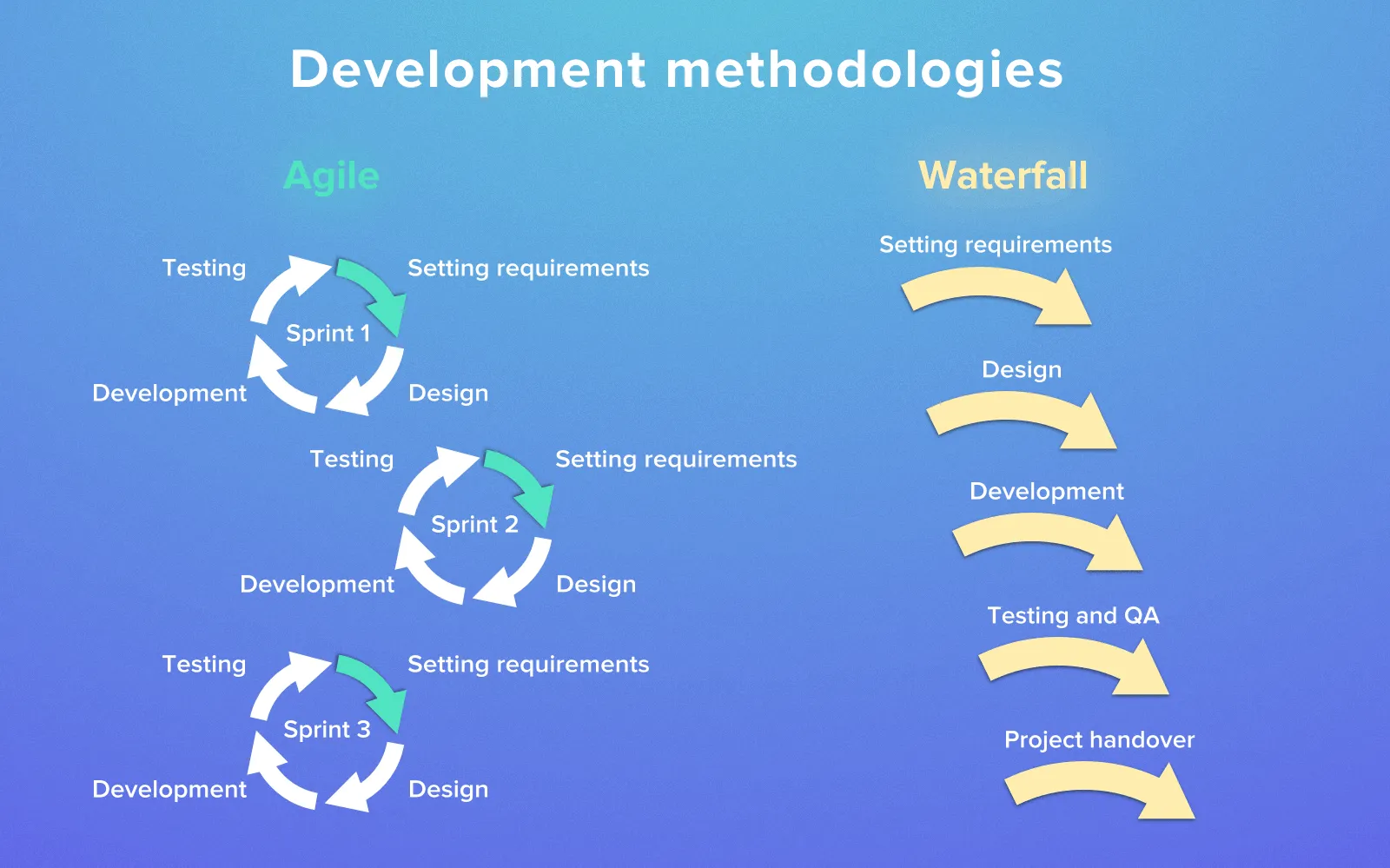
Depending on the business requirements we can use specific development methodologies
This approach does not imply breaking the workflow for the short periods. The complete sequence of actions is recorded in advance, so it is difficult, if not impossible to make any changes, since it will affect the main course of development.
Note that the company works out a project strictly according to the specification given by the client and disclaims liability for any drawbacks in the application architecture. However, before you start, the managers should indicate all the shortcomings of Waterfall methodology and propose possible solutions. If the customer agrees, the team starts working by Agile in fixed price project.
What are the advantages of Fixed Price model?
Opting for a fixed price project means you gain a pile of benefits of fixed price model is the best suited for the implementation of non-current projects. Take a look at the list below:
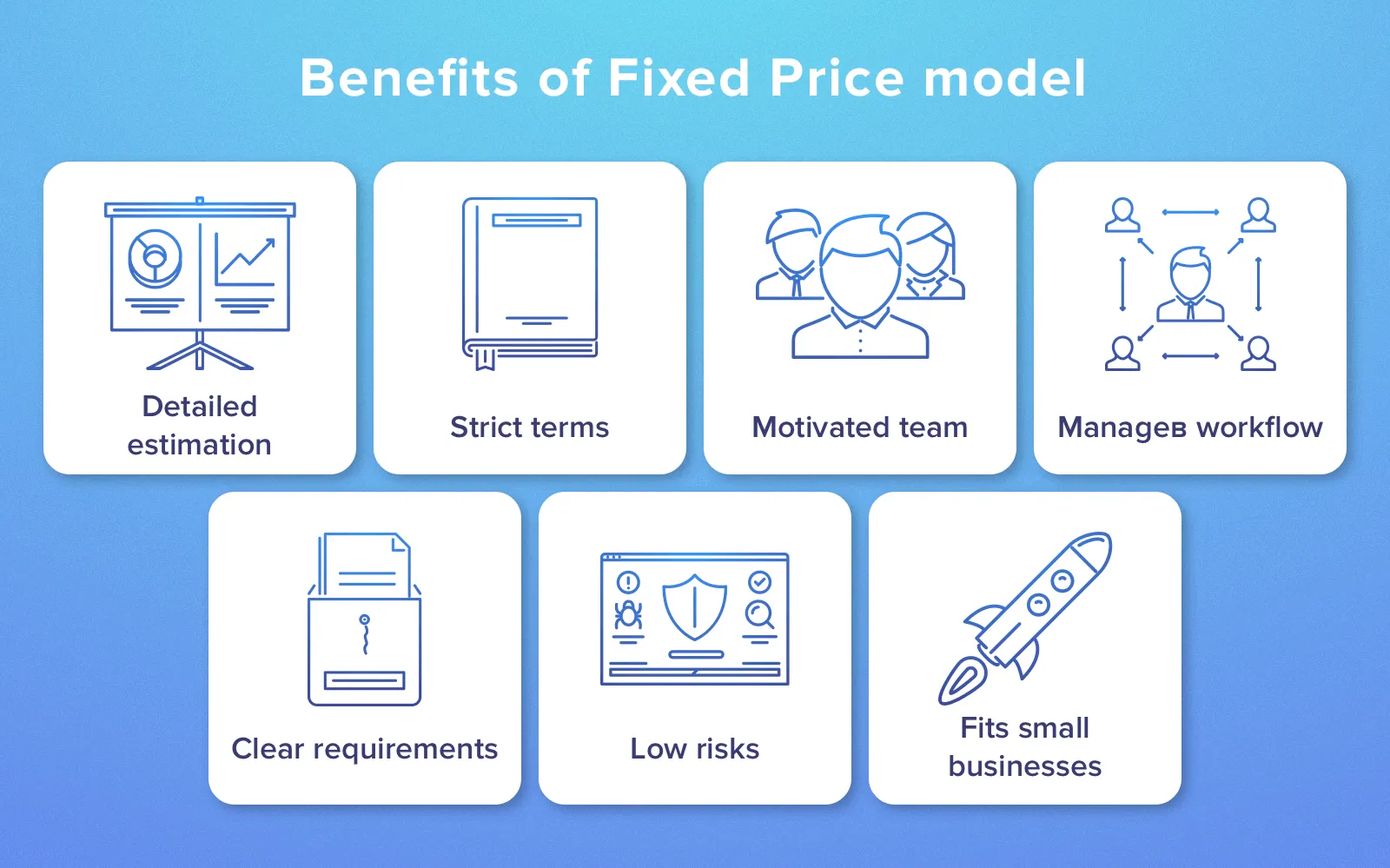
Advantages of Fixed Price contract
Detailed written price. You understand exactly how much and what you are paying for. The Pricing terms are documented, so no one can present you with an invoice for additional costs.
Strict terms of performance. You know the precise date when specific functionality will be developed. Only an extraordinary force majeure may prevent the timely delivery of work.
Highly motivated team. Since your employees get paid for the actual result rather than for hours spent in the office, they will do their best to implement a quality product within the time period allowed.
No need to manage the workflow. When you decide on a fixed price model, outsourcing company executes project supervision for you. Your participation is kept to a minimum. Thus, you can be sure that your product is being implemented under the guidance of a professional leader.
Clear-cut requirements and goals. You know exactly which feature will be implemented upon completion of a certain period. The employees perform only strictly defined tasks and are not allowed to depart from the terms of the contract unilaterally.
Low risks. The lowest probability of incurring losses for the client is also among the advantages of fixed price contract. In contrast, the development team is likely to bear all costs, in the case, it cannot meet the specified requirements.
We created simple tutorial to guide you through the outsourcing programming
A good fit for small businesses. Projects of a short duration require special pricing and management models in order to establish the most efficient workflow in a limited time. Using a fixed price model in the construction of your product, you choose the most suitable option.
A lot of free time:). So, you've explained to the developers what you need, signed an agreement, made an upfront payment... What's next? Well, you can drink coffee, read your favorite book, sunbathe on the beach, or become engaged in other things - you are totally free. The work is being done for you without your participation.
What are the Fixed Price project risks?
It is commonly known that nothing is perfect. This is also true for the fixed cost pricing model. To be clear about the negatives, pay attention to some disadvantages of fixed price project:
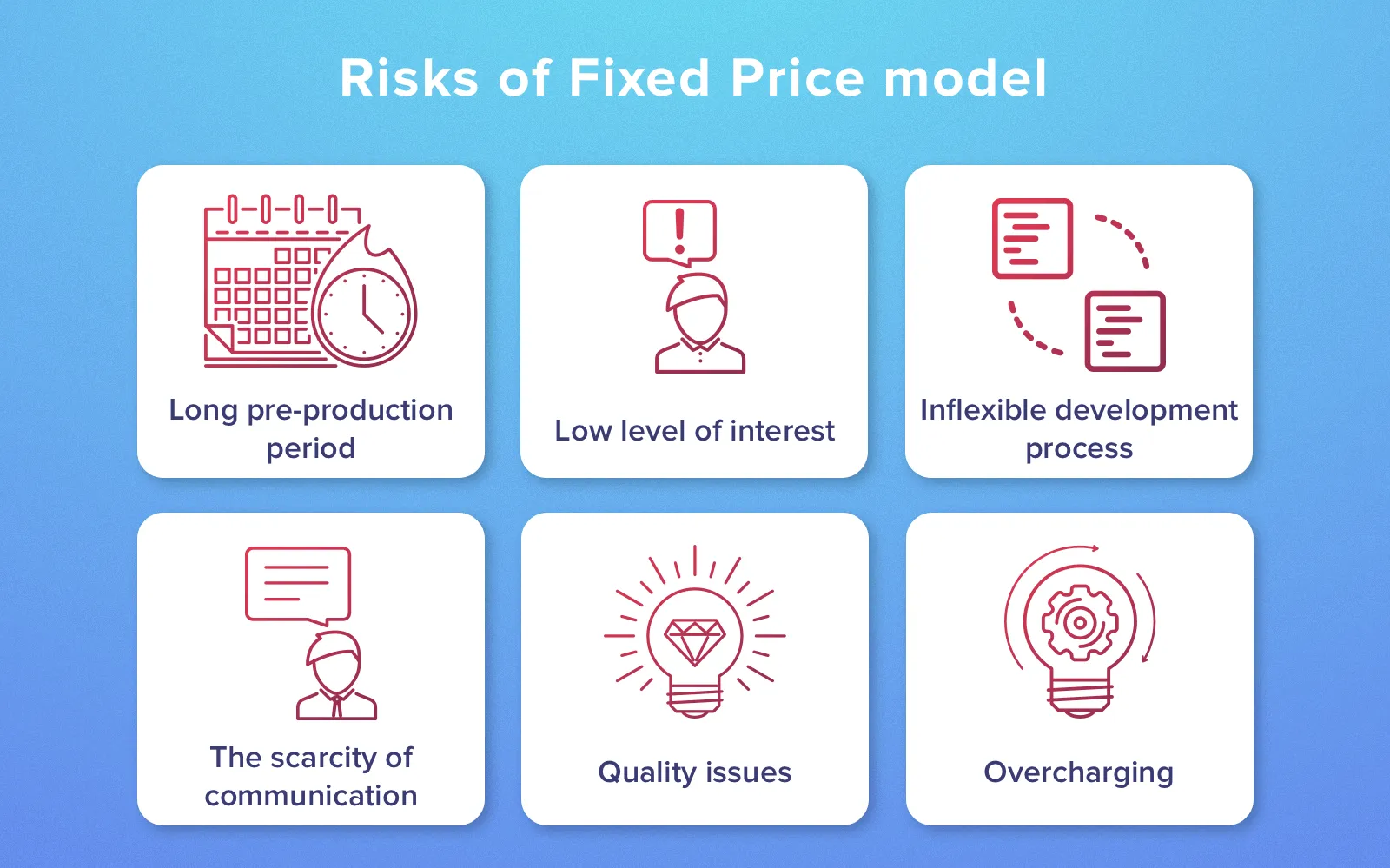
Possible disadvantages of Fixed Price project
Overlong pre-production period. If you want the develop processes to be fast and clear, you have to work hard in the preparatory phase of the project. Most of the time is to should be devoted to the discussion, documentation, and verification of all the details. Nevertheless, the effort is worth it, as you are going to receive the product just the way you imagine it without any nasty surprises.
Low level of participation interest. On the one hand - it is good that the workflow is being controlled by professional managers, on the other - you might want to become engaged in the process to a greater extent, however, a fixed price project model does not involve this. In any case, this does not mean that your opinion is going to be overridden.
Inflexible development process. All the steps are strictly prescribed. The development team may alter the process only at the level of shifting the task priorities. In the case where you want to move the development process in a totally different direction, you will have to go through the contract preparation procedure again. As a result, you sign an additional agreement and get a bill for the bolt-on services.
The scarcity of communication. Usually, the team gets in touch with the client once a day during the daily meetings. This is rather seldom compared to other models which imply ongoing communication. This does not mean that you are prohibited from caring about progress, however, frequent interaction with the developers is not expected in the fixed price business model.
The probability of obtaining a product with some issues. A famous proverb says: "If you want a thing done well, do it yourself". Well, we cannot argue with people's wisdom and will be frank: you might face some shortcomings with the output since you do not control the project yourself. However, this may happen irrespective of the type of contract you sign. Either way, the team must correct bugs without a surcharge.
Overcharging. One of the Fixed Price project risks is a chance to be overcharged if you give an unclear formulation of requirements. If for some reason you get misunderstood at the preparation stage and your instructions are documented incorrectly, you will have to correct this by inking an extra deal and thus pay additional costs.
These were pros and cons of fixed price contracts. Let's now define if they are worth the candle.
Is Fixed Price project worth the candle?
In conclusion, I would like to give a reasoned response regarding the appropriateness of using a fixed price model for software development. To cut a long story short, I say: "Yes". For all it's shortcomings, this model is the only win-win option for the customer. Even though you are not involved directly in the fixed price project management, it does not mean that the product you receive will not meet your expectations.
Having coordinated all the parameters, you disclaim all liability and are free to do whatever you like. Development takes place with little participation on your part. All you have to do is to check the accuracy of the original product and it's compliance to the previously elaborated specification.
For successful and productive cooperation, choose a reliable firm which is experienced in mobile and web development. Discuss the mutual work down to the smallest detail until you are sure this is a safe choice.
Well, this was a theoretical course on managing a fixed price project. To start the practice, please contact our specialists. You will see how quickly and efficiently it is possible to embody your idea into a revenue generating product.
This cooperation is based on a fixed cost which is charged for the work specified in advance. A fixed price project means just that. The price the quoted based on a specified amount of work and cannot be changed once the contract is signed.
This is the perfect choice for short projects. As a rule, their duration is not more than three - five months. A mandatory condition for entering into the contract is the ability to describe the future product (e.g., mobile or web application) in vivid detail. You should be abundantly clear about the capability and performance of the final software. In turn, the development team should work on every aspect following Agile methodology and offer a fixed price project estimation.
- Detailed estimation
- Strict terms
- Motivated team
- Managed workflow
- Clear requirements
- Low risks
- Fits small business
- Long pre-production period
- Low level of interest
- Inflexible development process
- The scarcity of communication
- Quality issues
- Overcharging

Evgeniy Altynpara is a CTO and member of the Forbes Councils’ community of tech professionals. He is an expert in software development and technological entrepreneurship and has 10+years of experience in digital transformation consulting in Healthcare, FinTech, Supply Chain and Logistics
Give us your impressions about this article
Give us your impressions about this article